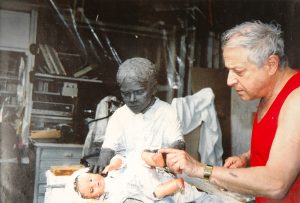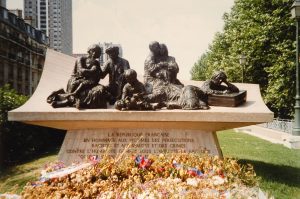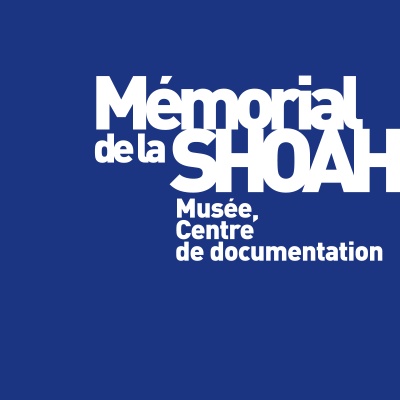
Walter Spizer works on the character of the little girl in the future monument dedicated to the roundup of the Vel d'hiv, 1994
Shoah Memorial/Spitzer coll.
The painter and sculptor Walter Spitzer, survivor of the Holocaust, died on April 13, 2021.
Born on 14 June 1927 in Cieszyn, a Polish town on the border with Czechoslovakia, Walter Spitzer drew from the age of four. His father is a liquor maker and his mother is a railway employee.
From the invasion of Poland, the 1er September 1939, begins the persecution of the Jews. The Jews of Cieszyn will be moved to the ghetto of Strzemieszyce, where they undergo violence and humiliation. Walter must work, first at a photographer’s place, then in a factory as a welder.
During a raid in June 1943, his half-brother, his sister, and his nephew are executed. He will later learn that his mother was also killed. His father died in 1940 of illness. Walter, for his part, is sent to the vast forced labour complex of Blechhammer in Upper Silesia, attached to the Auschwitz-III camp in April 1944. Assigned to a construction commando, he is then transferred to an office thanks to his drawing skills which allow him to improve his daily life by swapping his sketches, made with paper and scrap coal. In 2005, he will explain: "I never thought that the drawings I made in the camps were an act of resistance. I was just drawing.” In this camp, he establishes an unfailing friendship with Jules Fainzang, a Pole like him but deported from France five years his senior.
In front of the advance of the Soviet troops, Blechhammer is evacuated in January 1945. Walter and Jules join their comrades at the Gross-Rosen camp then at the Buchenwald camp where they are registered on February 10, 1945. Walter is protected by the clandestine organization of the Resistance which makes him pass through the "Grand camp" and he is registered as an electrician. In exchange, they commit him to testify by drawing the ordeals suffered, once freedom is regained.
Evacuated again at the beginning of April, he manages to escape with Jules around Jena and both are taken in charge by American troops.
Orphan from now on, Walter decides to follow his friend Jules to France. He started studies at the School of Fine Arts in Paris. Unable to bring back from deportation his drawings, he reproduces them from memory. He designs a composite and remarkable work. It notably illustrates the works of Malraux, Sartre or Kessel. He is the winner of the competition for the creation of a monument in Paris to pay tribute to the victims of the Vel d'Hiv raid, inaugurated in July 1994 by the President of the Republic François Mitterrand.
He is the author in 2004 of a book of memories Saved by the drawing to the editions Favre, prefaced by the Nobel Peace Prize Elie Wiesel.
Walter Spitzer is a Knight of the Legion of Honor, an officer of the National Order of Merit and a Knight of Arts and Letters.

The commemorative monument of the Winter Velodrome Roundup created by Walter Spitzer, quai de Grenelle, Paris (15th arrondissement). France, 1994
The Shoah Memorial sends its sincere condolences to his wife and children and salutes the memory of one of the great artists of the memory of the Shoah.


